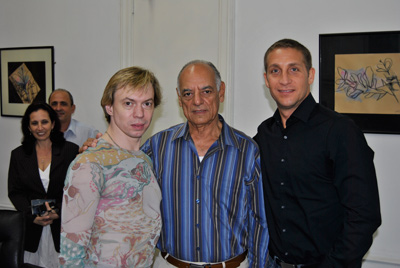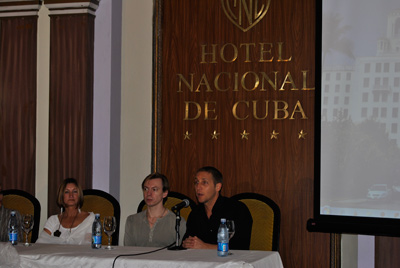Vladimir Malakhov’s Manager Paul Seaquist on the Dancer’s Ten Days in Cuba
By Helson Hernandez (Photos: Victoria Prada)

HAVANA TIMES — Paul Seaquist, manager of the man who is considered the century’s best dancer, speaks to us about Vladmir Malakhov’s recent visit to Cuba in an exclusive interview for Havana Times. “We’ve decided to return and to continue contributing to the arts in Holguin,” he told us.
HT: Tell us about your experiences during Un regalo de Malakhov (“A Gift from Malakhov”) in Cuba.
Paul Seaquist: After working with Vladmir Malakhov in Cuba for nearly ten days, I have only good things to say about our experiences on the island. We had the fortune of being able to stage our show, Un Regalo de Malakhov, in the marvelous city of Holguin, the right place for this gift, a place that has earned all of our affection and respect.
It almost feels as though the performance had been preordained. As a businessman, I did everything in my power to stage the show in Havana, but doors simply didn’t open for me there. I realized later I knocked on the wrong doors. In Holguin, however, they agreed to the project almost immediately. I learned something that’s hard to understand sometimes, that things work when the time and place are right.
HT: I hear the direct contact you had with the public exceeded your expectations.
PS: Seeing how the people of Holguin were overcome with emotion during our visit, to the point of naming Vladimir Malakhov an “honorary resident” of the city, was incredible for us. Seeing the theatre fill up for our two performances and the standing ovations Malakhov received every time he came on stage, and how his admirers would stand in endless lines at the end of the show just to have a photo taken with him or ask him for an autograph, was simply spectacular.
On countless occasions, people approached us on the street to shake our hands and simply thank us for being there. My answer was always the same: “Thank you for having invited us and given us this opportunity to offer you this modest gift.”
HT: They say more than 600 people gathered in front of Holguin’s Eddy Suñol theater.

PS: On December 5, Cuban dancers staged a show called “A Gift to Malakhov from Cuban Dancers”, as tribute to us. Seven, first-class dance companies participated: Holguin’s Codanza, in my opinion and almost without a doubt the best contemporary dance company in Cuba right now (from the artistic and human points of view), the city’s Chamber Ballet company, the Camaguey ballet company, the Endedanz contemporary ballet company, Santiago de Cuba’s Ad Libintum and Guantanamo’s Danza Fragmentada (“Fragmented Dance”), all of whom made a deep impression on us.
Before the start of the performance, an exhibition of photographs of Malakhov by the great Spanish photographer Pere Aral was inaugurated in the lobby of the theatre. When I went into the theatre with Vladmir and my team, around a thousand people were waiting for us, dying to see the show and to be part of the celebration.
Suddenly, all of them began to chant in unison, saying “Malakhov, Malakhov, Malakhov!” I couldn’t believe it. Their affection was real and palpable. I realized immediately we were in the right place at the right time.
HT: Tell us about your encounter with the great painter from Holguin, Cosme Proenza.
PS: One of the people we saw during our visit was Cosme Proenza, the distinguished, internationally renowned painter from Holguin. Proenza was kind enough to invite us to his home for breakfast one morning. Malakhov and I had the honor of meeting and learning from this master painter while drinking coffee with him. We talked about 19th century painting, pre and post-tsarist art, Franz Kafka and Malakhov’s collection of paintings in Berlin.
Later, with the kindness that he is known for, Cosme offered us a tour of his home and workshop and showed us his most recent works. We were very pleasantly surprised when, at the end of our visit, he gave us a painting dedicated to Vladimir Malakhov.
An opportunity to meet with someone like Proenza doesn’t come along every day, and we felt truly blessed. Needless to say, we invited him to our shows, to take part in our performance and take away a part of our art, as gift.
HT: Malakhov’s performances in Cuba gave rise to some future projects.
PS: Now that we’ve had our first experience in Holguin, we’ve decided to return and to continue contributing to the arts in the city. We know that our contribution is tiny in the big scheme of things or from the macro-economic point of view, but it is the only way we can and know how to contribute. I am an inveterate dreamer, and I’ve had the fortune of finding other dreamers in Cuba, people who are willing to work together to turn these ideas into reality.

The first, great dreamer I want to acknowledge is Maricel Godoy, the director of Codanza, who had the wisdom and vision to accept our proposal. She and her dance company worked tirelessly so that everything would fall into place at the right moment. Malakhov and I are very loyal people, we are grateful for and understand the kind of work and effort that went into organizing our performance in Holguin. That is why we’ve decided that our future projects will continue to be for and in Holguin for a long time to come.
HT: Give us more details about these future projects.
PS: First of all, we’ve created the “Great Malakhov Award”, which dancers will begin to receive in Holguin as of the last week of September and the first week of October of 2014. The award will acknowledge the work of individual dancers and of Cuban, Caribbean and Latin American dance companies.
The aim is to encourage young, talented dancers in our continent and to try and have them reach their highest potential. Vladimir Malakhov will be responsible for critically assessing these dancers and companies and choosing those who are to receive this distinction.
Secondly, we are planning a joint performance with the Holguin choir and Codanza. It’s a nice story. While in Holguin, we were invited to a performance by the choir, who sang in honor of Malakhov.
During the performance, I started to think about what we could do to fuse ballet and the opera artistically. At the end of show, I met with Concepcion Casals, the director of the choir, and I suggested we share ideas and work together to make this project a reality. In less than 24 hours, we had set up a work team with Codanza, the choir and the Council for the Performance Arts, all eager to get this new dream going.
I don’t want to go into further detail about the project. I can tell you, however, that this new project is going to delight people in Holguin and Cuba in ways we’ve never seen before. It will involve total collaboration among musicians, dancers and choreographers. I will be responsible for writing and staging the story.
HT: Have these cultural privileges Holguin is enjoying given rise to any discomfort in Havana?
PS: In the course of our careers, we’ve learned that doing things out of love is the best and healthiest way to go. Ill feelings are a kind of poison that destroys those who harbor these feelings and those who receive them. Vladimir Malakhov has a huge heart, where there is no room for envy or ill will – he’s proven it with this gift he’s given Cuba.

Personally, I’ve learned that, in the world of art, and particularly in ballet, we need to work with more affection and less arrogance, more love and less pride, and to look more towards the future than the past. We must begin to do away with the destructive practices we see in our world so often, until they have disappeared completely in a hopefully not too distant future.
The important thing, I think, is to work together, to look for a common language, to remember that, though we have different perspectives, we are all on the same boat, rowing for the good of others, to move forward, to become better professionals and better people.
Everyone in Cuba showed us immense affection and kindness during our visit, from Havana to Holguin, from the Minister of Culture, Mr. Rafael Bernal, to the doorman at the Eddy Suñol theater, from the Chair of the Council for the Performance Arts to the waitresses at the Hotel Nacional, from the directors of the dance companies that paid tribute to us to the public that was overcome with emotion during our performances.
I had this dream more than two years ago and worked tirelessly, non-stop, to make it a reality. Today, it no longer belongs to me. It belongs to all of the people of Cuba, from east to west and north to south, to everyone, without exception.

Maybe it is not a review but a summary of Mr. Seaquist´s experience on the island…
This article seems to promote more Seaquist than Vladimir Malakhov. What a pitiful review for an artist of Malakhov’s caliber.
Amazing!!! Thank you Mr. Seaquist!! Cuba needs more people like you!